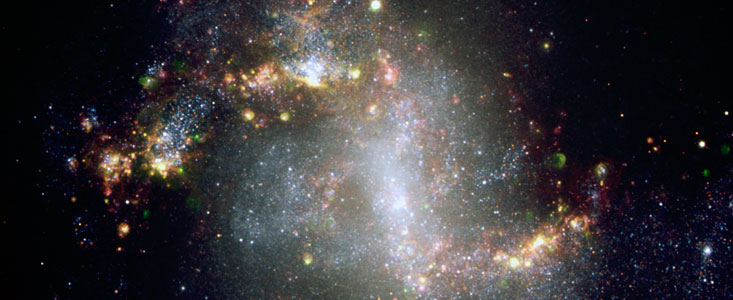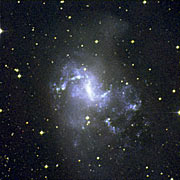Komunikat prasowy
The Topsy-Turvy Galaxy
VLT Image of Starburst Galaxy NGC 1313
23 listopada 2006
The captivating appearance of this image of the starburst galaxy NGC 1313, taken with the FORS instrument at ESO's Very Large Telescope, belies its inner turmoil. The dense clustering of bright stars and gas in its arms, a sign of an ongoing boom of star births, shows a mere glimpse of the rough times it has seen. Probing ever deeper into the heart of the galaxy, astronomers have revealed many enigmas that continue to defy our understanding.
This FORS image of the central parts of NGC 1313 shows a stunning natural beauty. The galaxy bears some resemblance to some of the Milky Way's closest neighbours, the Magellanic Clouds. NGC 1313 has a barred spiral shape, with the arms emanating outwards in a loose twist from the ends of the bar. The galaxy lies just 15 million light-years away from the Milky Way - a mere skip on cosmological scales. The spiral arms are a hotbed of star-forming activity, with numerous young clusters of hot stars being born continuously at a staggering rate out of the dense clouds of gas and dust. Their light blasts through the surrounding gas, creating an intricately beautiful pattern of light and dark nebulosity.
But NGC 1313 is not just a pretty picture. A mere scratch beneath the elegant surface reveals evidence of some of the most puzzling problems facing astronomers in the science of stars and galaxies. Starburst galaxies are fascinating objects to study in their own right; in neighbouring galaxies, around one quarter of all massive stars are born in these powerful engines, at rates up to a thousand times higher than in our own Milky Way Galaxy.
In the majority of starbursts the upsurge in star's births is triggered when two galaxies merge, or come too close to each other. The mutual attraction between the galaxies causes immense turmoil in the gas and dust, causing the sudden 'burst' in star formation.
NGC 1313's appearance suggests it has seen troubled times: its spiral arms look lop-sided and gas globules are spread out widely around them. This is more easily seen in ESO Press Release eso0643, showing a larger area of the sky around the galaxy. Moreover, observations with ESO's 3.6-m telescope at La Silla have revealed that its 'real' centre, around which it rotates, does not coincide with the central bar. Its rotation is therefore also off kilter.
Strangely enough NGC 1313 seems to be an isolated galaxy. It is not part of a group and has no neighbour, and it is not clear whether it may have swallowed a small companion in its past. So what caused its asymmetry and stellar baby boom?
An explanation based on the presence of the central bar also does not hold for NGC 1313: the majority of its star formation is actually taking place not in its bar but in dense gassy regions scattered around the arms. By what mechanism the gas is compressed for stars to form at this staggering rate, astronomers simply aren't sure.
Probing further into NGC 1313's insides reveals yet more mysteries. In the midst of the cosmic violence of the starburst regions lie two objects that emit large amounts of highly energetic X-rays - so-called ultra-luminous X-ray sources (ULX). Astronomers suspect that they might be black holes with masses of perhaps a few hundred times the mass of our Sun each, that formed as part of a binary star system. How such objects are created out of ordinary stars cannot be conclusively explained by current models.
NGC 1313 is an altogether very intriguing target for astronomy. This image, obtained with ESO's Very Large Telescope, demonstrates once again how the imager FORS is ideally suited to capturing the beauty and stunning complexity of galaxies by observing them in different wavelength filters, combined here to form a stunning colour image.
A high resolution image (with zoom-in possibilities) and its caption is available on this page.
Więcej informacji
Technical Information: ESO Press Photo eso0643a is a colour-composite based on images obtained with the FORS1 instrument on one of the 8.2-m Unit Telescope of ESO's Very Large Telescope, located at Cerro Paranal. The data were obtained in the night of 16 December 2003, through different broad- (R, B, and z) and narrow-band filters (H-alpha, OI, and OIII). The data were extracted from the ESO Science Archive and fully processed by Henri Boffin (ESO). ESO Press Photo eso0643b is made from images from the Digital Sky Survey, obtained through blue, red and infrared filters. The data was extracted and colour-composed by Henri Boffin (ESO).
O komunikacie
| Komunikat nr: | eso0643 |
| Legacy ID: | PR 43/06 |
| Nazwa: | NGC 1313 |
| Typ: | Local Universe : Galaxy : Type : Spiral |
| Facility: | Very Large Telescope |
| Instrumenty: | FORS1 |
Our use of Cookies
We use cookies that are essential for accessing our websites and using our services. We also use cookies to analyse, measure and improve our websites’ performance, to enable content sharing via social media and to display media content hosted on third-party platforms.
ESO Cookies Policy
The European Organisation for Astronomical Research in the Southern Hemisphere (ESO) is the pre-eminent intergovernmental science and technology organisation in astronomy. It carries out an ambitious programme focused on the design, construction and operation of powerful ground-based observing facilities for astronomy.
This Cookies Policy is intended to provide clarity by outlining the cookies used on the ESO public websites, their functions, the options you have for controlling them, and the ways you can contact us for additional details.
What are cookies?
Cookies are small pieces of data stored on your device by websites you visit. They serve various purposes, such as remembering login credentials and preferences and enhance your browsing experience.
Categories of cookies we use
Essential cookies (always active): These cookies are strictly necessary for the proper functioning of our website. Without these cookies, the website cannot operate correctly, and certain services, such as logging in or accessing secure areas, may not be available; because they are essential for the website’s operation, they cannot be disabled.
Functional Cookies: These cookies enhance your browsing experience by enabling additional features and personalization, such as remembering your preferences and settings. While not strictly necessary for the website to function, they improve usability and convenience; these cookies are only placed if you provide your consent.
Analytics cookies: These cookies collect information about how visitors interact with our website, such as which pages are visited most often and how users navigate the site. This data helps us improve website performance, optimize content, and enhance the user experience; these cookies are only placed if you provide your consent. We use the following analytics cookies.
Matomo Cookies:
This website uses Matomo (formerly Piwik), an open source software which enables the statistical analysis of website visits. Matomo uses cookies (text files) which are saved on your computer and which allow us to analyze how you use our website. The website user information generated by the cookies will only be saved on the servers of our IT Department. We use this information to analyze www.eso.org visits and to prepare reports on website activities. These data will not be disclosed to third parties.
On behalf of ESO, Matomo will use this information for the purpose of evaluating your use of the website, compiling reports on website activity and providing other services relating to website activity and internet usage.
Matomo cookies settings:
Additional Third-party cookies on ESO websites: some of our pages display content from external providers, e.g. YouTube.
Such third-party services are outside of ESO control and may, at any time, change their terms of service, use of cookies, etc.
YouTube: Some videos on the ESO website are embedded from ESO’s official YouTube channel. We have enabled YouTube’s privacy-enhanced mode, meaning that no cookies are set unless the user actively clicks on the video to play it. Additionally, in this mode, YouTube does not store any personally identifiable cookie data for embedded video playbacks. For more details, please refer to YouTube’s embedding videos information page.
Cookies can also be classified based on the following elements.
Regarding the domain, there are:
- First-party cookies, set by the website you are currently visiting. They are stored by the same domain that you are browsing and are used to enhance your experience on that site;
- Third-party cookies, set by a domain other than the one you are currently visiting.
As for their duration, cookies can be:
- Browser-session cookies, which are deleted when the user closes the browser;
- Stored cookies, which stay on the user's device for a predetermined period of time.
How to manage cookies
Cookie settings: You can modify your cookie choices for the ESO webpages at any time by clicking on the link Cookie settings at the bottom of any page.
In your browser: If you wish to delete cookies or instruct your browser to delete or block cookies by default, please visit the help pages of your browser:
Please be aware that if you delete or decline cookies, certain functionalities of our website may be not be available and your browsing experience may be affected.
You can set most browsers to prevent any cookies being placed on your device, but you may then have to manually adjust some preferences every time you visit a site/page. And some services and functionalities may not work properly at all (e.g. profile logging-in, shop check out).
Updates to the ESO Cookies Policy
The ESO Cookies Policy may be subject to future updates, which will be made available on this page.
Additional information
For any queries related to cookies, please contact: pdprATesoDOTorg.
As ESO public webpages are managed by our Department of Communication, your questions will be dealt with the support of the said Department.


